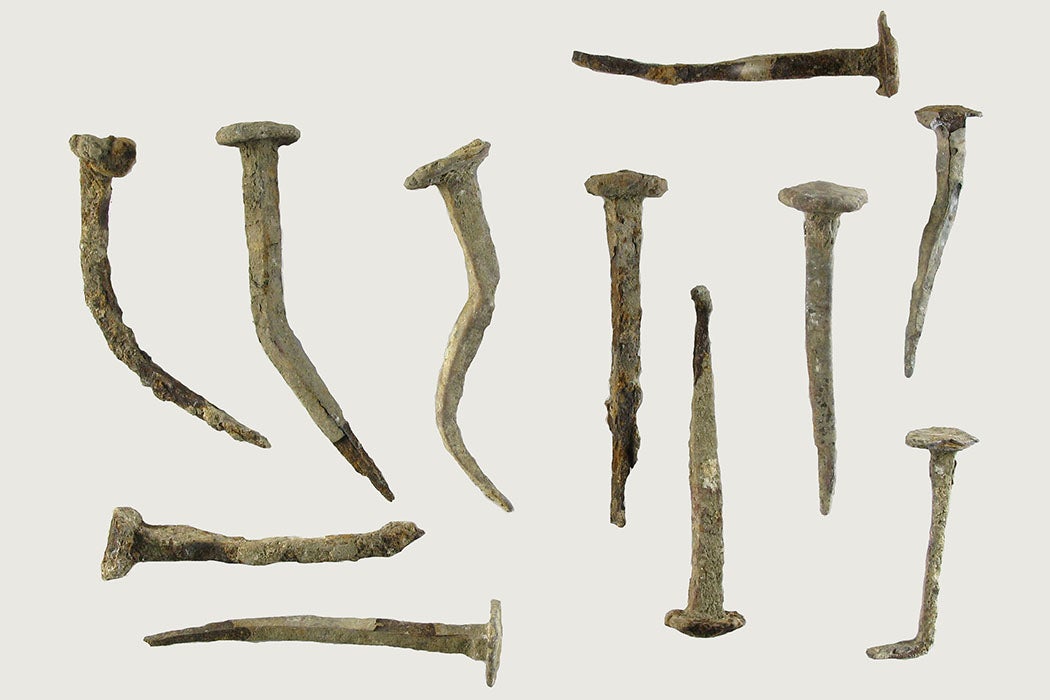The metalworkers of the Roman Empire produced prodigious amounts of iron, copper, and lead. The resulting pollution can still be traced as far away as the ice of Greenland. After the collapse of the imperium at the beginning of the fifth century CE, Europe would not produce as much copper-smelting pollution until the nineteenth century.
Medieval historian Robin Fleming describes the “extraordinary capacity” of the “Roman metal economy” to produce metals for local markets. Her example is Britain, off shore on the northwestern edge of the empire. It was “awash with inexpensive, readily available, ready-to-smith metal as well as finished metal goods” as a result of the empire’s complex and interconnected networks of mining, charcoal-making, smelting, and smithing—and all the skilled workers that forged these components together.
Fleming cites a “simultaneously quotidian and astonishing” archaeological discovery at the site of a “short-lived, first-century Roman fort at Inchtuthil” in Scotland. Discovered in 1960, this was a cache of more than 875,000 “well-made nails” in a “variety of standard sizes and hardnesses.” The cache is astonishing for more than its size. Its preservation after centuries of intensive recycling of Roman metal is quite remarkable.
The material prosperity all the good, cheap metal made possible—especially for the top 15 percent of the population—was upended by the Roman state’s withdrawal from Britain in the early 400s CE. The end of the imperium was a severe blow to the British economy. The result was a “deskilling and impoverishment” of a population whose standard of living nose-dived across the board. Post-Roman Britain became a very poor place. The radical economic and political dislocations resulting from the collapse, Fleming writes, became the foundations of the medieval world.
“Metal supply sits at the heart of two important stories that can help us to understand the years between 350 and 600,” she writes, “the calamitous material impoverishment of post-collapse Britain, and the gradual re-establishment of a hierarchical society.”
By the last decades of the fourth century, new metal production was breaking down. British metalworking sites, with three centuries of experience behind them, show evidence of a turn towards reworking existing metal instead of making new metal. But by 420, these sites were abandoned. It wasn’t just a question of supply: Britain “could no longer sustain specialist communities of skilled workers producing for the market.”
It was the practices that today we could consider “scavenging and recycling…in the last couple of generations of the Roman period [that] came to be the primary way the vast number of people in lowland Britain would supply themselves with workable metal for the next several hundred years.”
Fortunately, there were literally tons of left-over metal in abandoned Roman towns, forts, villas, and temples. These were largely stripped, resulting in Roman ruins notably lacking the metals clearly used in their construction. Recycled scrap metal hoards have become archaeological sites in their own right. Recycled metal could be reforged or used as is: things like spoons, bracelets, and ear scoops (a.k.a. spoons or picks) seem to have been treasured by a people who no longer knew how to make new versions of these once every-day items.
Weekly Newsletter
One way of tracking iron-smelting is to measure the amount of slag produced as a byproduct. Roman Britain produced a lot of it, for instance the estimated 100,000 tons that destroyed a Roman bath house in Beauport Park when the slag heap accidentally collapsed. Yet only minor amounts of slag can be dated to the fifth and sixth centuries; iron smelting didn’t disappear completely, but it was nothing like it had been. Likewise, the tradition of burying metal as votive offerings around bodies ceased for generations; instead, there’s evidence such older sites were dug up for their metal.
History is typically portrayed as progress, things getting better and better. The end of Roman Britain was the reverse. It wasn’t just metal. Mass produced wheel-thrown pottery largely disappeared for 300 years. Saws were replaced by less efficient axes for 600 years. The examples continue in Fleming’s 2021 book, The Material Fall of Roman Britain, 300–525 CE, which details a shattering regression affecting every aspect of society, culture, and life—a story told today by the things left behind.
Support JSTOR Daily! Join our membership program on Patreon today.







